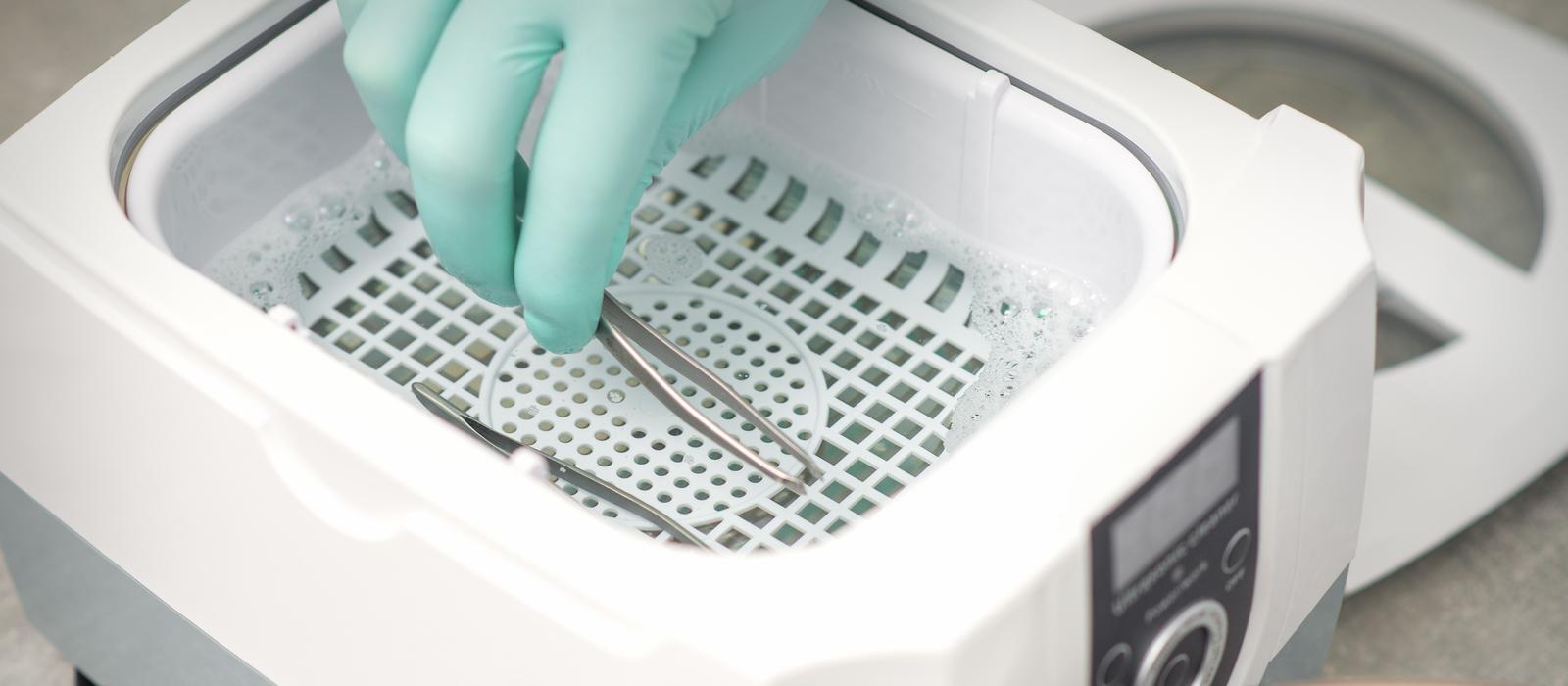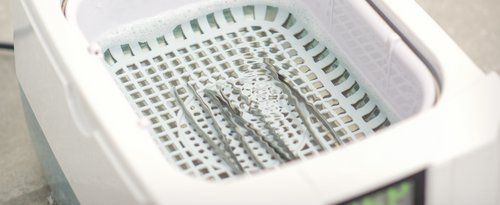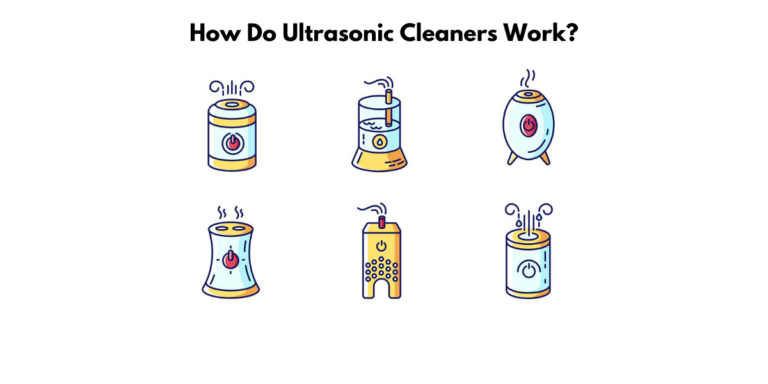A Guide on Ultrasonic Cleaner: Everything you need to know before getting one
What you need to know before getting an ultrasonic cleaner
An ultrasonic cleaner is a device that uses sound waves to clean things. It’s often used to clean jewelry, eyeglasses, and other delicate items.
If you’re considering getting an ultrasonic cleaner, you should know a few things before purchasing. In this guide, we will cover everything you need to know about ultrasonic cleaners so that you can make an informed decision.

What is an ultrasonic cleaner?
An ultrasonic cleaner is a device that uses sound waves to clean objects. Ultrasonic cleaners are used in various industries, including jewelry, eyeglass, and medicine. They work by creating high-frequency sound waves that create cavitation bubbles in the liquid. These bubbles collapse and create a scrubbing action that can remove dirt, grime, and other contaminants from surfaces.
How does an ultrasonic cleaner work?
Ultrasonic cleaners work by immersing an object in a solution of water or solvent and emitting high-frequency sound waves, typically at 40kHz. This causes the liquid molecules to agitate, producing cavitation bubbles on the object’s surface. These bubbles then implode with great force, blasting dirt particles off the object’s surface and into the ultrasonic cleaner solution, where they can be easily removed. Additionally, the high-frequency waves create a cavitation effect, producing microscopic bubbles around the object, imploding and releasing dirt particles. This process provides a powerful cleaning action that can easily remove debris, dirt, grease, and other deposits from surfaces. Furthermore, surfactants, such as laundry detergent, can be added to the solution to dissolve non-polar compounds like oils and greases.
What is the difference between an ultrasonic cleaner and a regular cleaner?
The main difference between an ultrasonic cleaner and a regular cleaner is that an ultrasonic cleaner uses high-frequency sound waves to create cavitation bubbles in a cleaning liquid. In contrast, a regular cleaner relies on physical scrubbing or chemical detergents. Ultrasonic cleaners are available in various sizes and can clean many items, including automotive parts, medical devices, jewelry, dental instruments, eyeglasses, and more. They operate at frequencies between 20 and 400 kHz and typically use water or a water-based solution as the cleaning fluid. Ultrasonic cleaners are more effective at removing hard-to-remove deposits than regular cleaners. Regular cleaners use manual scrubbing or chemical detergents to clean objects, which can be less effective for hard-to-remove deposits.

What are the benefits of using an ultrasonic cleaner?
An ultrasonic cleaner is a versatile piece of equipment that can be used in several settings and for various cleaning tasks.
Ultrasonic cleaners use high-frequency sound waves to create cavitation bubbles in the liquid, which helps to break down dirt, grime, and other contaminants so they can be easily removed.
This type of cleaning is gentle enough not to damage delicate items like jewelry yet powerful enough to clean heavy-duty objects like tools and engine parts.
Cleans electronic devices and jewelry quickly and efficiently
An ultrasonic cleaner is a device that uses sound waves to clean electronic devices and jewelry quickly and efficiently. There are many benefits of using an ultrasonic cleaner, including the fact that they are very effective at removing dirt, dust, and other contaminants from surfaces. They are also very gentle on delicate items, making them ideal for cleaning electronic devices and jewelry. In addition, ultrasonic cleaners are relatively inexpensive and easy to use.
Removes dirt, grime, and contaminants
Ultrasonic cleaners use high-frequency ultrasound to create microscopic cavitation bubbles which implode violently, creating an intense scrubbing action on any surface to be cleaned. This scrubbing helps remove dirt, grime, and other unwanted contaminants. The cavitation bubbles can penetrate the tiniest crevices, holes, and recesses, ensuring that all traces of contamination are removed. The type of liquid used will depend on the type of contamination and the material being cleaned, with either water or solvents being the most common options.
A safe and effective way to clean electronics and jewelry
An ultrasonic cleaner can clean many items, including automotive parts, medical devices, jewelry, and dental instruments. Automotive parts such as spark plugs, carburetors, and fuel injectors can be thoroughly cleaned without damaging sensitive or delicate parts. Medical devices such as endoscopes, surgical instruments, catheters, and probes can be effectively and safely cleaned. Jewelry such as rings, earrings, watches, and necklaces can be cleaned to remove dirt, dust, and tarnish. Dental instruments such as forceps, scalers, and burs can be cleaned to remove bacteria or other contaminants. Eyeglasses, smartphones, and other electronics can also be safely and effectively cleaned with an ultrasonic cleaner.
It can be used to clean a wide variety of items
Ultrasonic cleaners can clean many items, including jewelry, dental and medical equipment, dishes, clothing, and other non-porous items that can be immersed in water. Examples include watches, eyeglasses, coins, dentures, silverware, surgical instruments, golf clubs, electric shavers, and car parts. Ultrasonic cleaners remove dirt, grime, and tough stains that normally require manual scrubbing.
Portable ultrasonic cleaner can be used at home
Yes, an ultrasonic cleaner can be used at home. Ultrasonic cleaners are electronic cleaning devices that use sound waves to clean objects. They are available in various sizes and can clean various items, such as automotive parts, medical devices, jewelry, and dental instruments. Ultrasonic cleaners can be used to quickly and efficiently remove grease, dirt, and other deposits from surfaces. They are easy to operate and can be used with or without heat, depending on the size and type of cleaned object. Additionally, some models of ultrasonic cleaners come with adjustable timers and temperature settings, making them even more convenient and versatile.
It can be used to clean a variety of items, from coins to eyeglasses
Automotive parts, medical devices, jewelry, dental instruments, eyeglasses, hardware, fasteners, small metal parts, and gemstones. Additionally, ultrasonic cleaners can remove dirt, tarnish, and grime without damaging any stones that may be set into the jewelry.
Helps to preserve the life of items being cleaned
Using an ultrasonic cleaner helps to preserve the life of items being cleaned by creating high-frequency ultrasonic wave vibrations that create microscopic bubbles. These bubbles implode violently and cause cavitation, which creates an intense scrubbing action on the surface of the item being cleaned. The microscopic nature of the bubbles means that even the tiniest crevices will be thoroughly cleaned, thus preserving the item’s life and keeping it in good condition for longer.
It can be used to remove rust, paint, and other materials
Using an ultrasonic cleaner, it is possible to safely and effectively remove soils, rust, oxides, common dirt, engine sludge, lubricants, grease, buffing and polishing compounds, cutting oils, and other oily chemicals from a variety of materials. Ultrasonic cleaning may not be suitable for the removal of spores and viruses, however. Other alternatives to ultrasonic cleaners include using a detergent and water solution with an air compressor or pressure washer, which can be effective for small parts that do not have intricate details.
Convenient and easy to use
How does an ultrasonic cleaner make use convenient and easy? With an ultrasonic cleaner, users can quickly and easily clean jewelry, including gold, silver, platinum, and gemstones, without damaging any stones that may be set in the jewelry. The ultrasonic cleaning process is straightforward; users just need to put the jewelry in the cleaner and turn it on. Ultrasonic cleaners are also highly effective at removing dirt and tarnish from jewelry. As such, they offer a convenient and easy way for users to keep their jewelry clean and looking its best.

What should you consider when buying an ultrasonic cleaner?
Ultrasonic cleaners are amazing little devices. They use high-frequency sound waves to create cavitation bubbles in a liquid. These bubbles collapse and create a scrubbing action that can clean things like jewelry, lenses, and even dental implants that would be difficult to clean with just soap and water.
If you’re thinking about buying an ultrasonic cleaner for your home or business, there are a few things you should consider before making your purchase:
Performance
The performance characteristics of an ultrasonic cleaner include the ability to rapidly and completely clean objects such as tools, glasses, and jewelry using high-frequency sound waves and a liquid cleaning solution. The bubbles created by the ultrasonic wave vibrations allow microscopic cleaning, even in the tiniest crevices. The bright LED display and easy push-button control make for convenient operation. Additionally, the rubber feet handle for portability and external drains for replenishment of the cleaning solution ensure that the Ultrasonic Cleaner can be used in various industries and applications.
Price
The price range for an ultrasonic cleaner varies greatly. Prices range from as low as $62.99 to as high as $356.99, depending on the size and features of the cleaner.
Size and weight
When choosing an ultrasonic cleaner, size and weight are two important considerations. Industrial cleaners come in larger tanks with robust generators delivering more power and higher-grade transducers. In comparison, lab-size or tabletop cleaners have smaller tanks, offering more accessories to assist with the cleaning process. Tank capacity, length, width, depth, and weight will vary depending on the brand and model of the cleaner.
Cleaning solution
When purchasing an ultrasonic cleaner, it is important to consider the cleaning solution that is best suited for the items being cleaned. In most cases, a cleaning solution is used as it can increase the effectiveness of the ultrasonic cleaning process. This solution typically contains detergents, wetting agents, and other components to reduce surface tension and maximize cleaning performance. Depending on the type of material and dirt you are trying to remove, the primary solvent may be water or a hydrocarbon. Additionally, solutions may be heated to specific temperatures, such as 50-65°C, and may contain alkaline detergents for better cleaning metals, proteins, and greases. Using plain water for ultrasonic cleaning is also possible, although it is not as effective as a cleaning solution.
Timer function
The timer function is an important factor to consider when purchasing an ultrasonic cleaner. A timer allows the user to easily and accurately control the duration of the cleaning cycle, ensuring that all contaminants are effectively removed. With a timer, the user can choose a preset cycle or select a specific duration depending on the item being cleaned and the amount of time needed for optimal results. Additionally, it is important to note that some ultrasonic cleaners come with a heated water function, and a timer allows the user to control the temperature needed for maximum cleaning effectiveness accurately. Ultimately, having a timer ensures that the user can accurately and effectively control the cleaning cycle, achieving the best possible results.
Noise level
The noise level of an ultrasonic cleaner is typically between 20 kHz and 400 kHz. This high-frequency sound creates cavitation bubbles in the cleaning liquid, ultimately producing a cleaning action that can remove stubborn dirt and grease. The level of frequency determines the kind of cleaning action, as a higher frequency will create smaller bubbles that are more gentle and detailed. In comparison, a lower frequency will create bigger bubbles that can provide more intense and aggressive cleaning. The Bransonic MH Series Ultrasonic Cleaner features a unique sweep frequency technology to eliminate standing waves and a pioneering 40 kHz industrial transducer, making it a reliable and high-quality option for various applications.
Accessories
Accessories for ultrasonic cleaners include baskets, mats, beakers and supports, lids, other solid pans and tubs, drying units, signifiers, and steam cleaners. These accessories allow for a more efficient and thorough cleaning process, allowing you to get the most out of your ultrasonic cleaner.
Warranty
An ultrasonic cleaner is a device designed to clean objects, such as jewelry, hardware, and surgical instruments, with ultrasonic sound waves. The ultrasonic sound waves generate high-frequency vibrations, which create tiny bubbles in the cleaning solution that help to remove dirt and grime from even the smallest crevices. Most ultrasonic cleaners come with a manufacturer’s warranty of up to 2.5 years, so you can take advantage of the warranty if you encounter any challenges with your jewelry cleaner machine. However, the warranty may be voided if the machine is abused or used incorrectly, so it’s important to make sure you read the instruction manual and use the machine according to the manufacturer’s specifications.
FAQs
Here are some of the most frequently asked questions about ultrasonic cleaners:
What liquid do you use in an ultrasonic cleaner?
An ultrasonic cleaner uses high-frequency sound waves produced by an ultrasonic transducer to create cavitation bubbles in a cleaning liquid. The liquid typically used in an ultrasonic cleaner is either water or a water-based solution. It may sometimes contain surfactants such as laundry detergent to help dissolve non-polar compounds such as oils and greases.
What can you clean with an ultrasonic cleaner?
Ultrasonic cleaners can be used to clean a wide range of items, including automotive parts, medical devices, jewelry, dental instruments, eyeglasses, small electronic parts, cables, rods, wires, detailed items, objects made of glass, plastic, aluminum, or ceramic, hard, non-absorbent materials (metals, plastics, etc.), gold, silver, platinum, diamonds, stainless steel and more. Additionally, ultrasonic cleaning removes contamination from industrial process equipment such as pipes and heat exchangers. The number of items that can benefit from ultrasonic cleaning is vast as long as they can be immersed without causing damage and can be dried relatively easily.
What happens if you put your hand in an ultrasonic cleaner?
If you put your hand in an ultrasonic cleaner, it can cause discomfort and skin irritation. The ultrasonic action is relatively benign to living tissue but can create cavitation bubbles that implode with great force; this can cause thermal or chemical injury. Therefore, it is important to use an ultrasonic cleaner and avoid contact with the cleaning solution. Additionally, it is important to take note of the risks of electric shock in case of malfunction and to use hearing protection in case of continuous exposure.
Do ultrasonic cleaners use chemicals?
Yes, ultrasonic cleaners use chemicals, usually in the form of a cleaning solution that contains detergents, wetting agents, and other components. This solution is designed to maximize the effectiveness of the ultrasonic cleaning process and reduce surface tension to increase cavitation, so the solution usually contains a good wetting agent (surfactant). In some cases, plain water can be used in an ultrasonic cleaner, but a cleaning solution is often used to achieve the best results.
Are ultrasonic cleaners safe to use?
Yes, ultrasonic cleaners are safe when the right precautions are taken. Ultrasonic cleaners create high-frequency noise that can be irritating, so hearing protection is recommended for continuous exposure. Additionally, explosive cleaning solutions should be avoided, as the ultrasonic energy produced by the machine can increase the temperature of the liquid even without a heater. It is also important to take caution when working with the cleaning solution, as contact can cause thermal or chemical injury to the skin. Furthermore, since the machine is electrically powered, there is a risk of electric shock if the cleaner malfunctions.
Despite these potential risks, ultrasonic cleaners are an efficient and effective way to clean various materials. The ultrasound produced by the machine helps to loosen deposits that are difficult to remove with traditional cleaning methods. Ultrasonic cleaners are also safe for relatively brittle materials like glass or ceramics. They can be used to clean everything from jewelry to automotive parts, medical devices, dental instruments, and more. In addition to cleaning, ultrasonic washers can passivate stainless steel by using a nitric or citric acid solution in the tank.
Overall, when used properly and with the necessary precautions, ultrasonic cleaners are a safe and efficient way to clean various objects.
How often can an ultrasonic cleaner be used?
Ultrasonic cleaners typically operate at frequencies between 20 kHz and 400 kHz and usually use water or a water-based solution as the cleaning fluid. The time required for ultrasonic cleaning varies depending on the material and amount of dirt, but it typically takes between 3 to 6 minutes. Since ultrasonic cleaners are so effective, they can be used as often as necessary. However, it is important to note that ultrasonic cleaning does not sterilize items, so that additional steps may be required for medical and other applications.
- A Guide on Ultrasonic Cleaner: Everything you need to know before getting one - January 27, 2023
- Tips for Sanitizing The Nursery For Your Baby’s Safety - February 20, 2022





